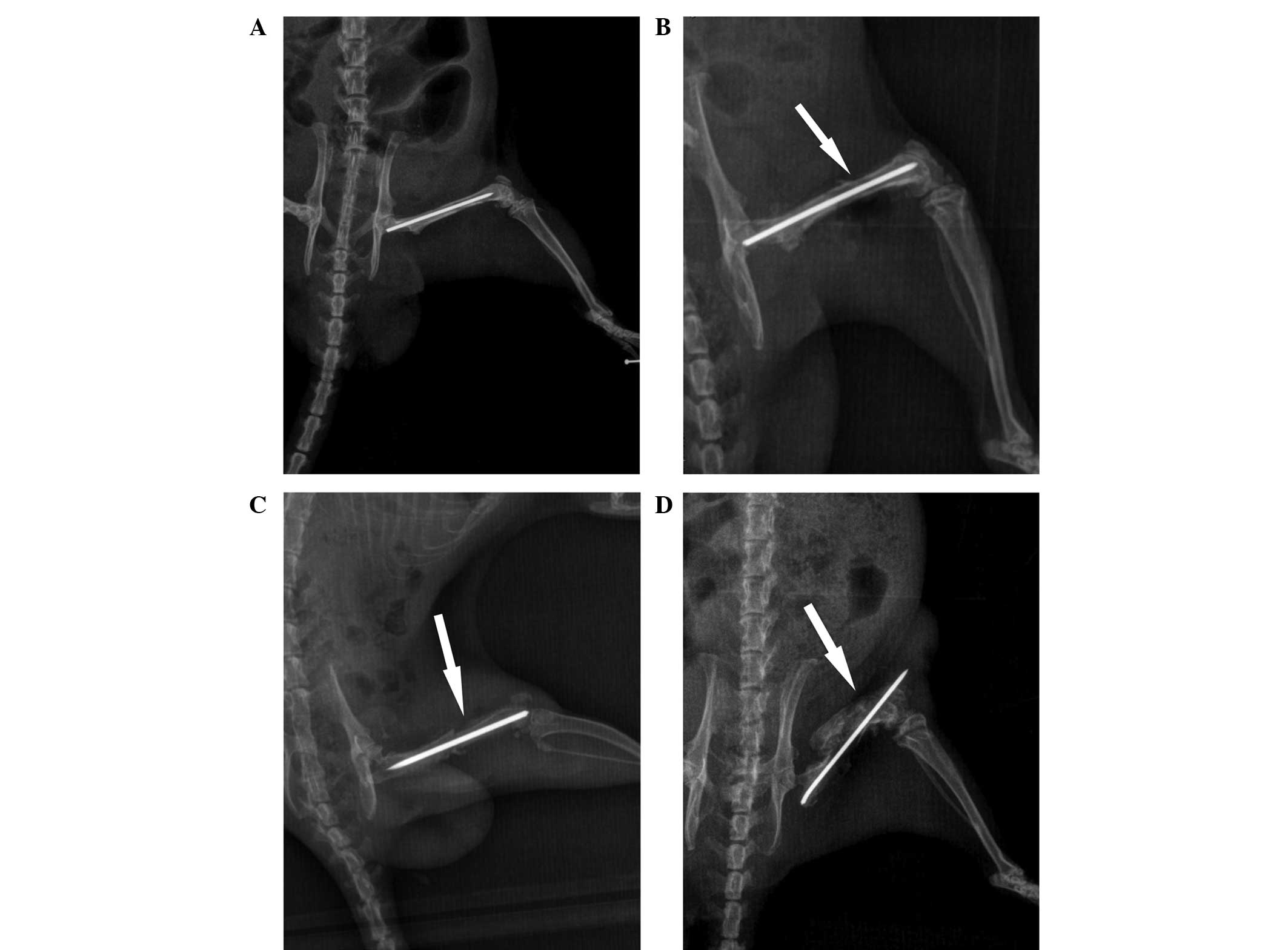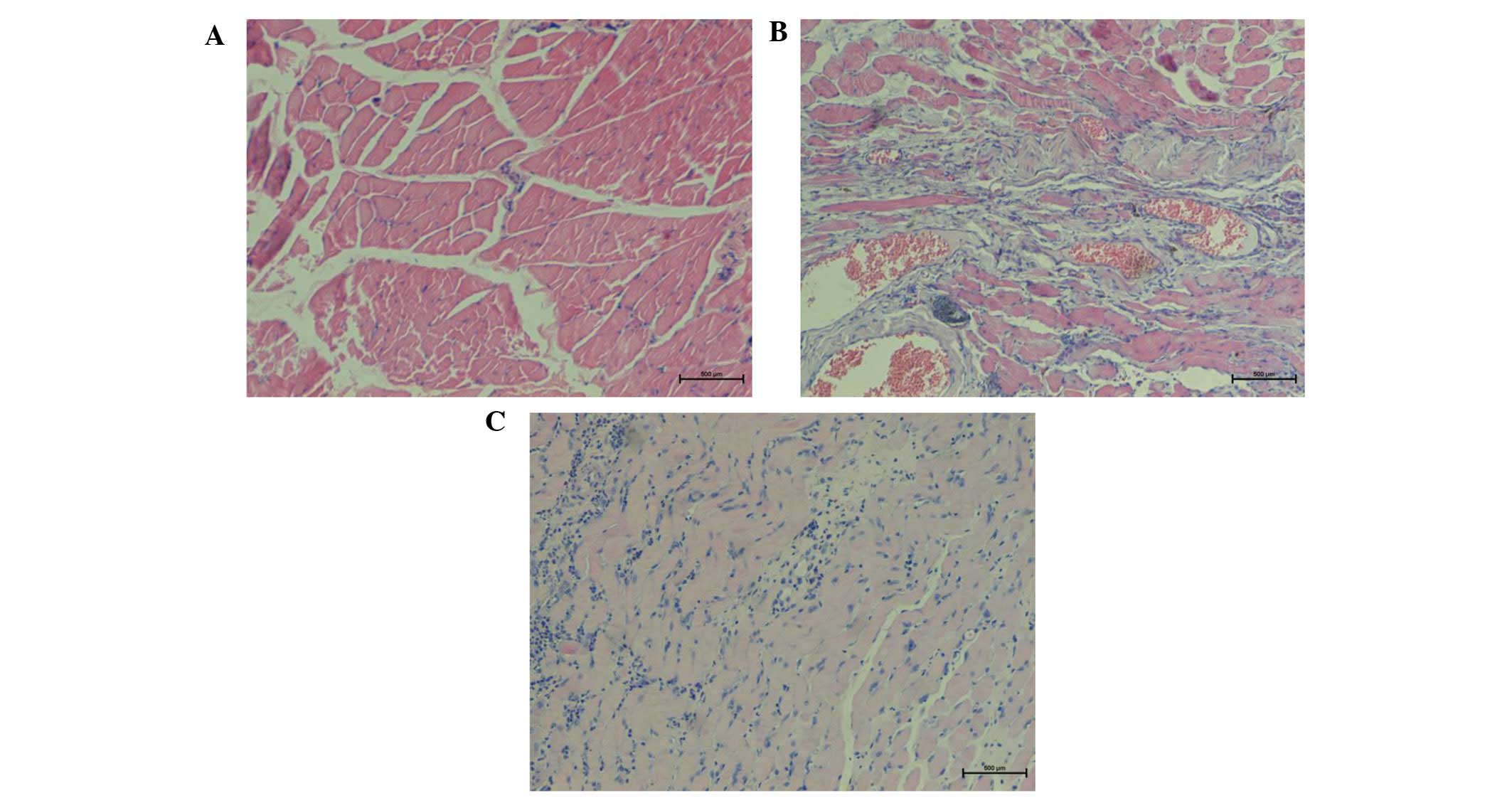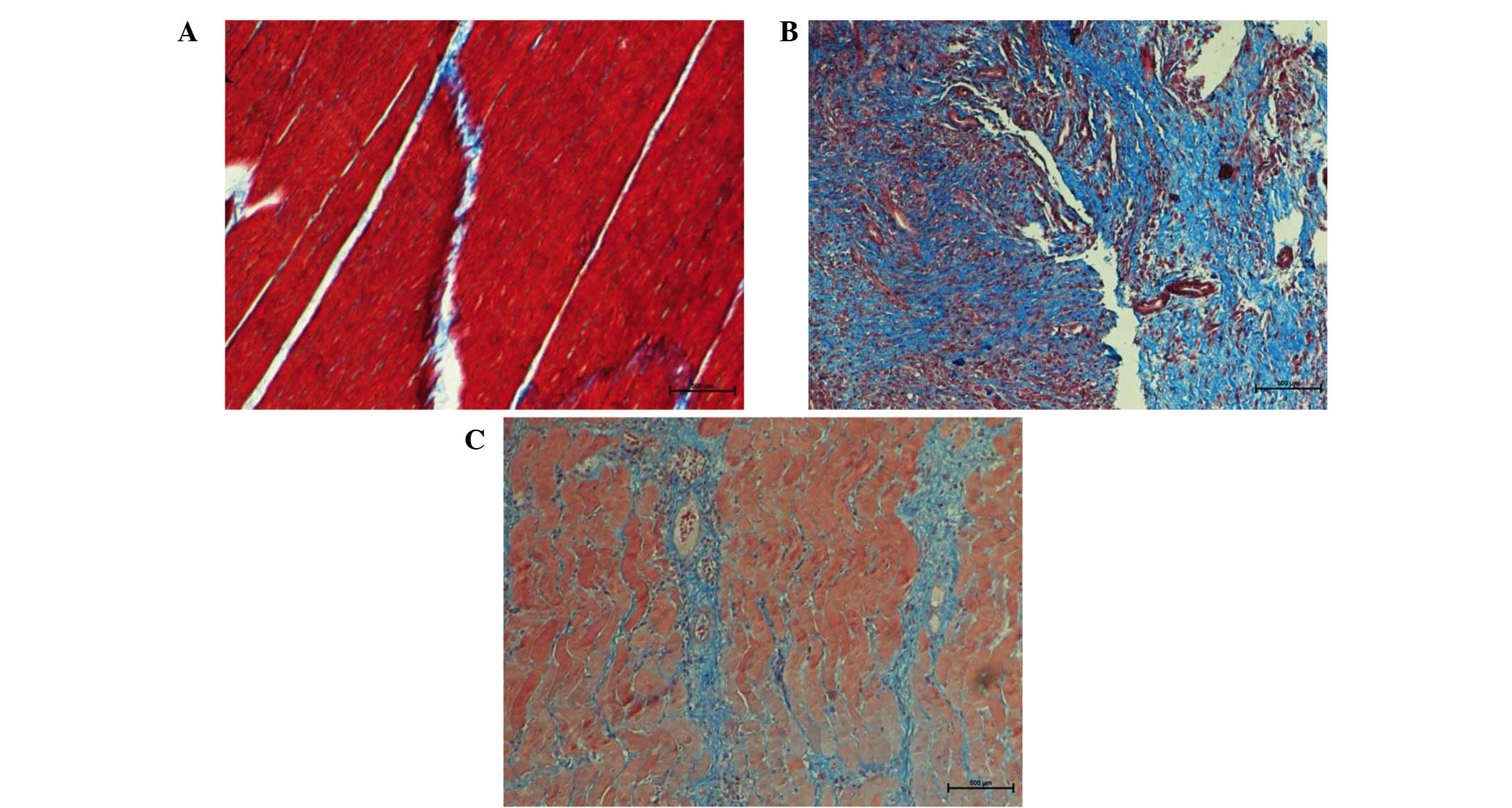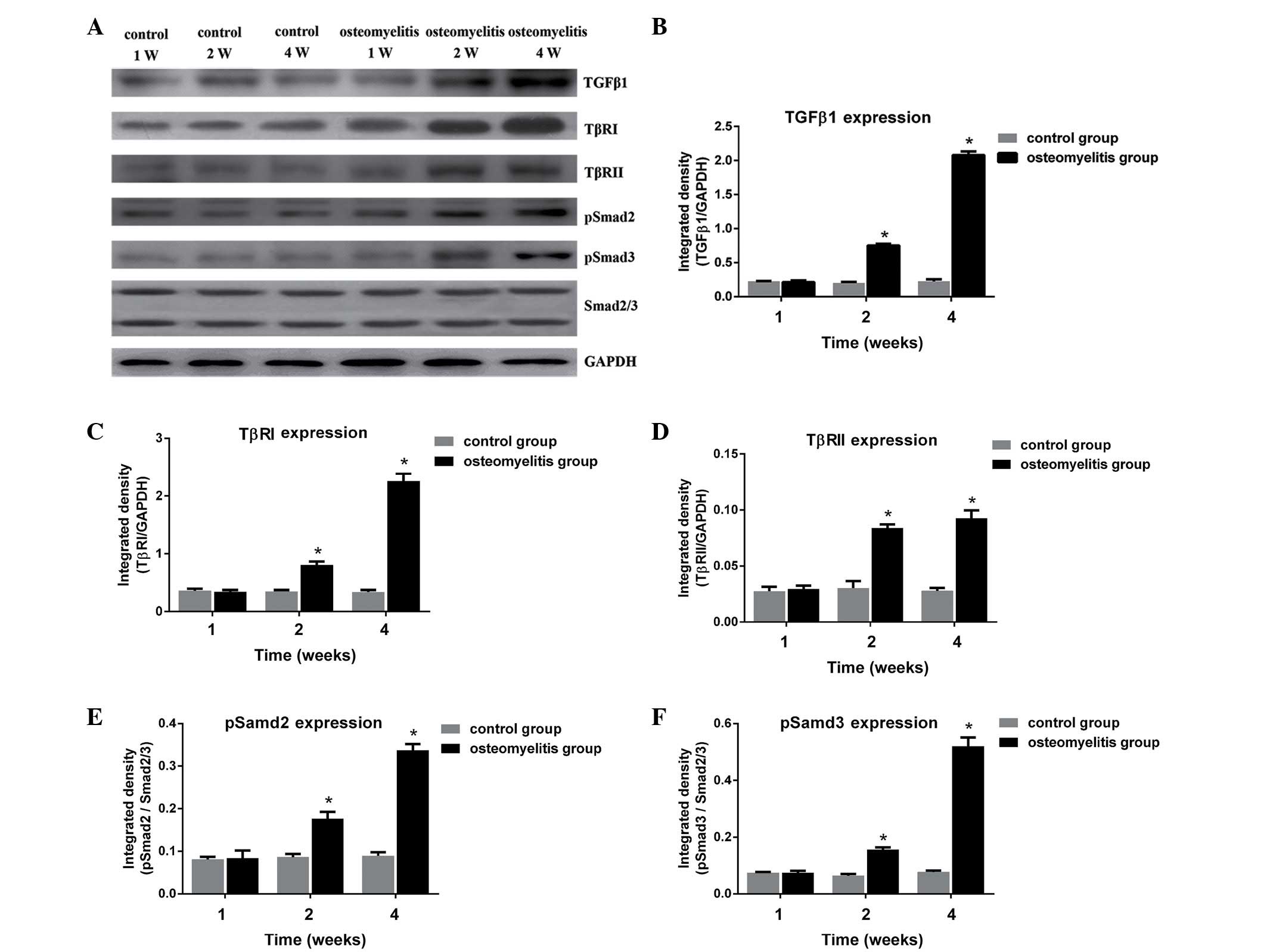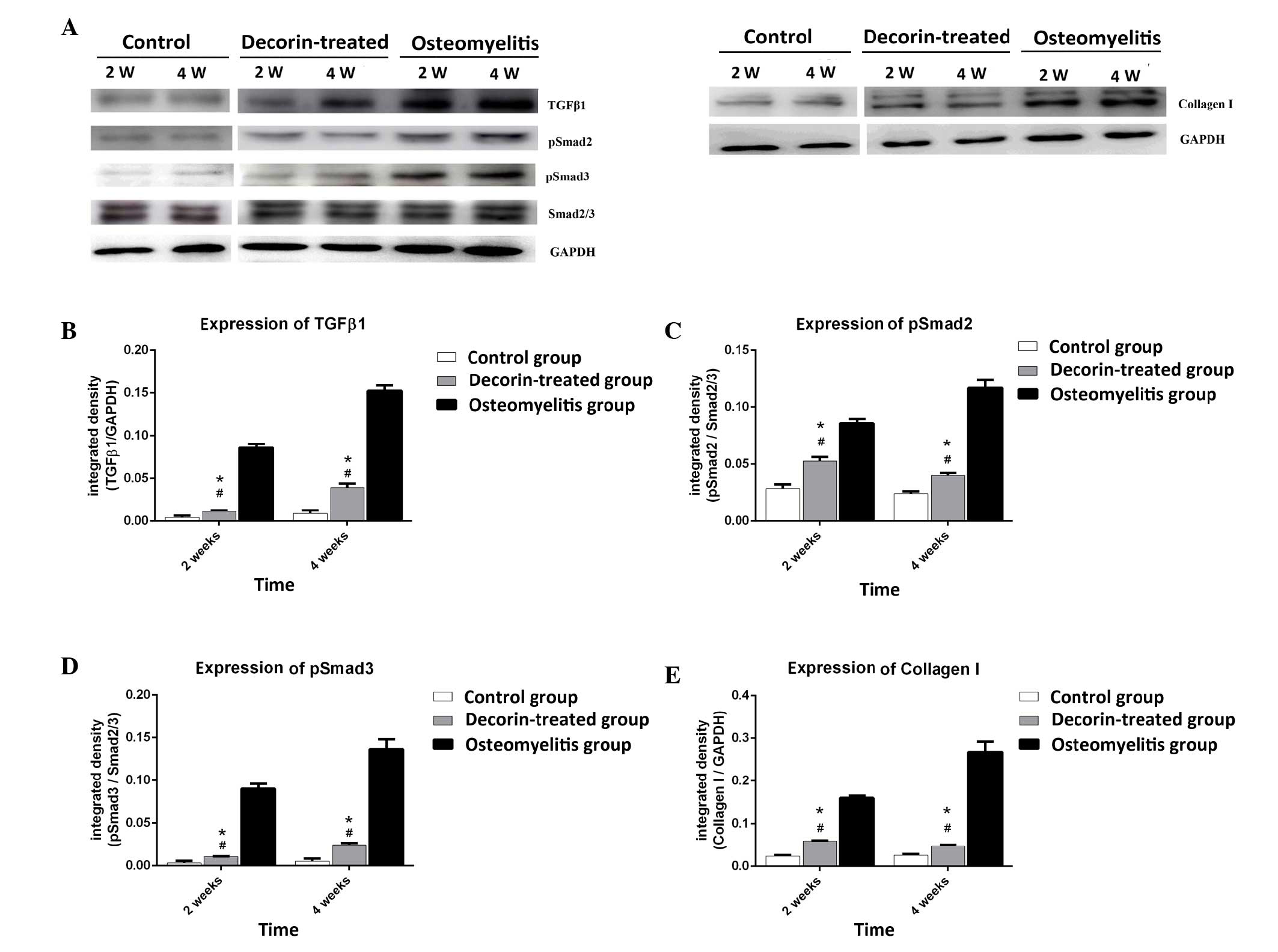|
1
|
Lazzarini L, De Lalla F and Mader JT: Long
bone osteomyelitis. Curr Infect Dis Rep. 4:439–445. 2002.
View Article : Google Scholar : PubMed/NCBI
|
|
2
|
Eid AJ and Berbari EF: Osteomyelitis:
Review of pathophysiology, diagnostic modalities and therapeutic
options. J Med Liban. 60:51–60. 2012.PubMed/NCBI
|
|
3
|
Papakostidis C, Bhandari M and Giannoudis
PV: Distraction osteogenesis in the treatment of long bone defects
of the lower limbs: Effectiveness, complications and clinical
results; a systematic review and meta-analysis. Bone Joint J 95-B.
1673–1680. 2013. View Article : Google Scholar
|
|
4
|
Lowenberg DW, Buntic RF, Buncke GM and
Parrett BM: Long-term results and costs of muscle flap coverage
with Ilizarov bone transport in lower limb salvage. J Orthop
Trauma. 27:576–581. 2013. View Article : Google Scholar : PubMed/NCBI
|
|
5
|
Xiao Z and Xi C: Hepatocyte growth factor
reduces hypertrophy of skin scar: In vivo study. Adv Skin Wound
Care. 26:266–270. 2013. View Article : Google Scholar : PubMed/NCBI
|
|
6
|
Sriram S, Robinson P, Pi L, Lewin AS and
Schultz G: Triple combination of siRNAs targeting TGFβ1, TGFβR2,
and CTGF enhances reduction of collagen I and smooth muscle actin
in corneal fibroblasts. Invest Ophthalmol Vis Sci. 54:8214–8223.
2013. View Article : Google Scholar : PubMed/NCBI
|
|
7
|
Cutroneo KR, White SL, Phan SH and Ehrlich
HP: Therapies for bleomycin induced lung fibrosis through
regulation of TGF-beta1 induced collagen gene expression. J Cell
Physiol. 211:585–589. 2007. View Article : Google Scholar : PubMed/NCBI
|
|
8
|
Zhang Z, Li XJ, Liu Y, Zhang X, Li YY and
Xu WS: Recombinant human decorin inhibits cell proliferation and
downregulates TGF-beta1 production in hypertrophic scar
fibroblasts. Burns. 33:634–641. 2007. View Article : Google Scholar : PubMed/NCBI
|
|
9
|
Inanmaz ME, Uslu M, Isik C, Kaya E, Tas T
and Bayram R: Extracorporeal shockwave increases the effectiveness
of systemic antibiotic treatment in implant-related chronic
osteomyelitis: Experimental study in a rat model. J Orthop Res.
32:752–756. 2014. View Article : Google Scholar : PubMed/NCBI
|
|
10
|
Kishor C, Mishra RR, Saraf SK, Kumar M,
Srivastav AK and Nath G: Phage therapy of staphylococcal chronic
osteomyelitis in experimental animal model. Indian J Med Res.
143:87–94. 2016. View Article : Google Scholar : PubMed/NCBI
|
|
11
|
Cheng Y, Wei H, Sun R, Tian Z and Zheng X:
Rapid method for protein quantitation by Bradford assay after
elimination of the interference of polysorbate 80. Anal Biochem.
494:37–39. 2016. View Article : Google Scholar : PubMed/NCBI
|
|
12
|
Orimolade EA, Olabanji JK, Oladele AO and
Yusuf MB: Chronic osteomyelitis in the lower extremity predisposing
to the unusual formation of keloids. Singapore Med J. 52:e190–e193.
2011.PubMed/NCBI
|
|
13
|
Wolfram D, Tzankov A, Pülzl P and
Piza-Katzer H: Hypertrophic scars and keloids - a review of their
pathophysiology, risk factors, and therapeutic management. Dermatol
Surg. 35:171–181. 2009. View Article : Google Scholar : PubMed/NCBI
|
|
14
|
Jia S, Zhao Y, Law M, Galiano R and Mustoe
TA: The effects of collagenase ointment on the prevention of
hypertrophic scarring in a rabbit ear scarring model: A pilot
study. Wounds. 23:160–165. 2011.PubMed/NCBI
|
|
15
|
Boudko SP, Engel J and Bächinger HP: The
crucial role of trimerization domains in collagen folding. Int J
Biochem Cell Biol. 44:21–32. 2012. View Article : Google Scholar : PubMed/NCBI
|
|
16
|
Bhogal RK, Stoica CM, McGaha TL and Bona
CA: Molecular aspects of regulation of collagen gene expression in
fibrosis. J Clin Immunol. 25:592–603. 2005. View Article : Google Scholar : PubMed/NCBI
|
|
17
|
Gharaee-Kermani M, Hu B, Phan SH and
Gyetko MR: Recent advances in molecular targets and treatment of
idiopathic pulmonary fibrosis: Focus on TGFbeta signaling and the
myofibroblast. Curr Med Chem. 16:1400–1417. 2009. View Article : Google Scholar : PubMed/NCBI
|
|
18
|
Whitman M: Smads and early developmental
signaling by the TGFbeta superfamily. Genes. 12:2445–2462. 1998.
View Article : Google Scholar
|
|
19
|
Joyce ME, Roberts AB, Sporn MB and
Bolander ME: Transforming growth factor-beta and the initiation of
chondrogenesis and osteogenesis in the rat femur. J Cell Biol.
110:2195–2207. 1990. View Article : Google Scholar : PubMed/NCBI
|
|
20
|
Hou XH, Cao B, Liu HQ, Wang YZ, Bai SF and
Chen H: Effects of osthole on apoptosis and TGF-beta1 of
hypertrophic scar fibroblasts. J Asian Nat Prod Res. 11:663–669.
2009. View Article : Google Scholar : PubMed/NCBI
|
|
21
|
Waddington SN, Crossley R, Sheard V, Howe
SJ, Buckley SM, Coughlan L, Gilham DE, Hawkins RE and McKay TR:
Gene delivery of a mutant TGFβ3 reduces markers of scar tissue
formation after cutaneous wounding. Mol Ther. 18:2104–2111. 2010.
View Article : Google Scholar : PubMed/NCBI
|
|
22
|
Massagué J: TGFbeta signaling: Receptors,
transducers and Mad proteins. Cell. 85:947–950. 1996. View Article : Google Scholar : PubMed/NCBI
|
|
23
|
Peltonen J, Kähäri L, Jaakkola S, Kähäri
VM, Varga J, Uitto J and Jimenez SA: Evaluation of transforming
growth factor beta and type I procollagen gene expression in
fibrotic skin diseases by in situ hybridization. J Invest Dermatol.
94:365–371. 1990. View Article : Google Scholar : PubMed/NCBI
|
|
24
|
Wang X, Smith P, Pu LL, Kim YJ, Ko F and
Robson MC: Exogenous transforming growth factor beta(2) modulates
collagen I and collagen III synthesis in proliferative scar
xenografts in nude rats. J Surg Res. 87:194–200. 1999. View Article : Google Scholar : PubMed/NCBI
|
|
25
|
Fan C, Dong Y, Xie Y, Su Y, Zhang X,
Leavesley D and Upton Z: Shikonin reduces TGF-β1-induced collagen
production and contraction in hypertrophic scar-derived human skin
fibroblasts. Int J Mol Med. 36:985–991. 2015.PubMed/NCBI
|
|
26
|
Bai X, He T, Liu J, Wang Y, Fan L, Tao K,
Shi J, Tang C, Su L and Hu D: Loureirin B inhibits fibroblast
proliferation and extracellular matrix deposition in hypertrophic
scar via TGF-β/Smad pathway. Exp Dermatol. 24:355–360. 2015.
View Article : Google Scholar : PubMed/NCBI
|
|
27
|
Deheuninck J and Luo K: Ski and SnoN,
potent negative regulators of TGF-beta signaling. Cell Res.
19:47–57. 2009. View Article : Google Scholar : PubMed/NCBI
|
|
28
|
Iozzo RV: Matrix proteoglycans: From
molecular design to cellular function. Annu Rev Biochem.
67:609–652. 1998. View Article : Google Scholar : PubMed/NCBI
|
|
29
|
Ameye L and Young MF: Mice deficient in
small leucine-rich proteoglycans: Novel in vivo models for
osteoporosis, osteoarthritis, Ehlers-Danlos syndrome, muscular
dystrophy and corneal diseases. Glycobiology. 12:107R–116R. 2002.
View Article : Google Scholar : PubMed/NCBI
|
|
30
|
Miura T, Kishioka Y, Wakamatsu J, Hattori
A, Hennebry A, Berry CJ, Sharma M, Kambadur R and Nishimura T:
Decorin binds myostatin and modulates its activity to muscle cells.
Biochem Biophys Res Commun. 340:675–680. 2006. View Article : Google Scholar : PubMed/NCBI
|
|
31
|
Ahmed Z, Bansal D, Tizzard K, Surey S,
Esmaeili M, Gonzalez AM, Berry M and Logan A: Decorin blocks
scarring and cystic cavitation in acute and induces scar
dissolution in chronic spinal cord wounds. Neurobiol Dis.
64:163–176. 2014. View Article : Google Scholar : PubMed/NCBI
|
|
32
|
Honardoust D, Varkey M, Hori K, Ding J,
Shankowsky HA and Tredget EE: Small leucine-rich proteoglycans,
decorin and fibromodulin, are reduced in postburn hypertrophic
scar. Wound Repair Regen. 19:368–378. 2011. View Article : Google Scholar : PubMed/NCBI
|
|
33
|
Kolb M, Margetts PJ, Sime PJ and Gauldie
J: Proteoglycans decorin and biglycan differentially modulate
TGF-beta-mediated fibrotic responses in the lung. Am J Physiol Lung
Cell Mol Physiol. 280:L1327–L1334. 2001.PubMed/NCBI
|
|
34
|
Zhu J, Li Y, Shen W, Qiao C, Ambrosio F,
Lavasani M, Nozaki M, Branca MF and Huard J: Relationships between
transforming growth factor-beta1, myostatin and decorin:
Implications for skeletal muscle fibrosis. J Biol Chem.
282:25852–25863. 2007. View Article : Google Scholar : PubMed/NCBI
|
|
35
|
Kishioka Y, Thomas M, Wakamatsu J, Hattori
A, Sharma M, Kambadur R and Nishimura T: Decorin enhances the
proliferation and differentiation of myogenic cells through
suppressing myostatin activity. J Cell Physiol. 215:856–867. 2008.
View Article : Google Scholar : PubMed/NCBI
|
|
36
|
Hakkinen L, Strassburger S, Kähäri VM,
Scott PG, Eichstetter I, Lozzo RV and Larjava H: A role for decorin
in the structural organization of periodontal ligament. Lab Invest.
80:1869–1880. 2000. View Article : Google Scholar : PubMed/NCBI
|
|
37
|
Fukushima K, Badlani N, Usas A, Riano F,
Fu F and Huard J: The use of an antifibrosis agent to improve
muscle recovery after laceration. Am J Sports Med. 29:394–402.
2001.PubMed/NCBI
|















